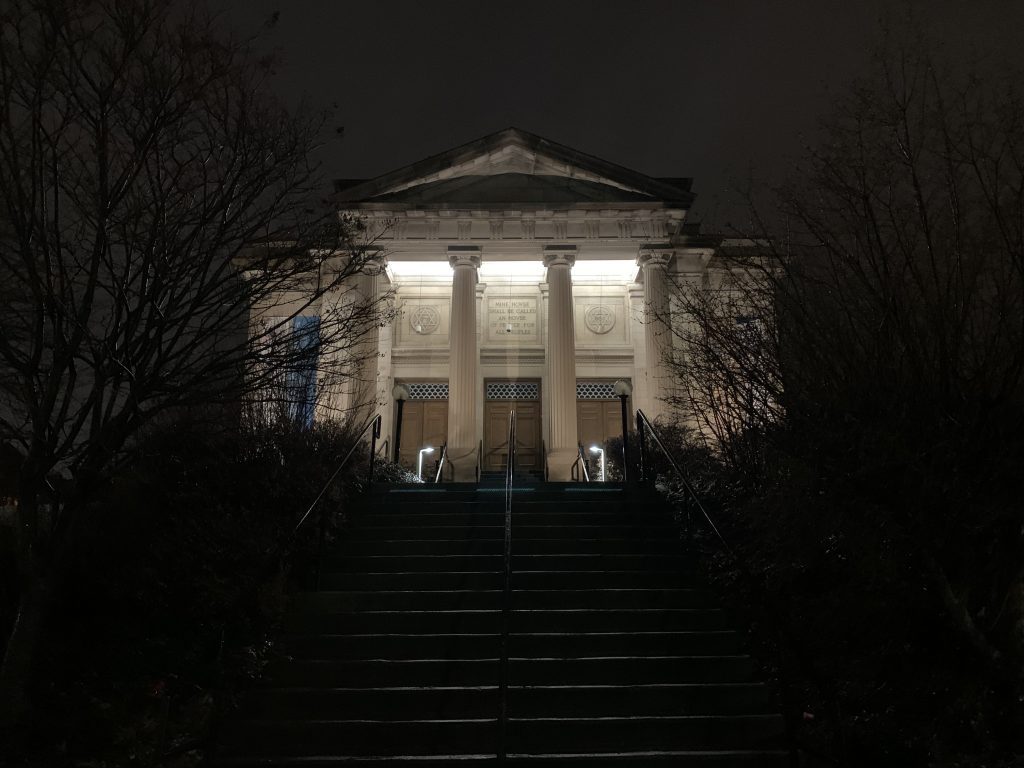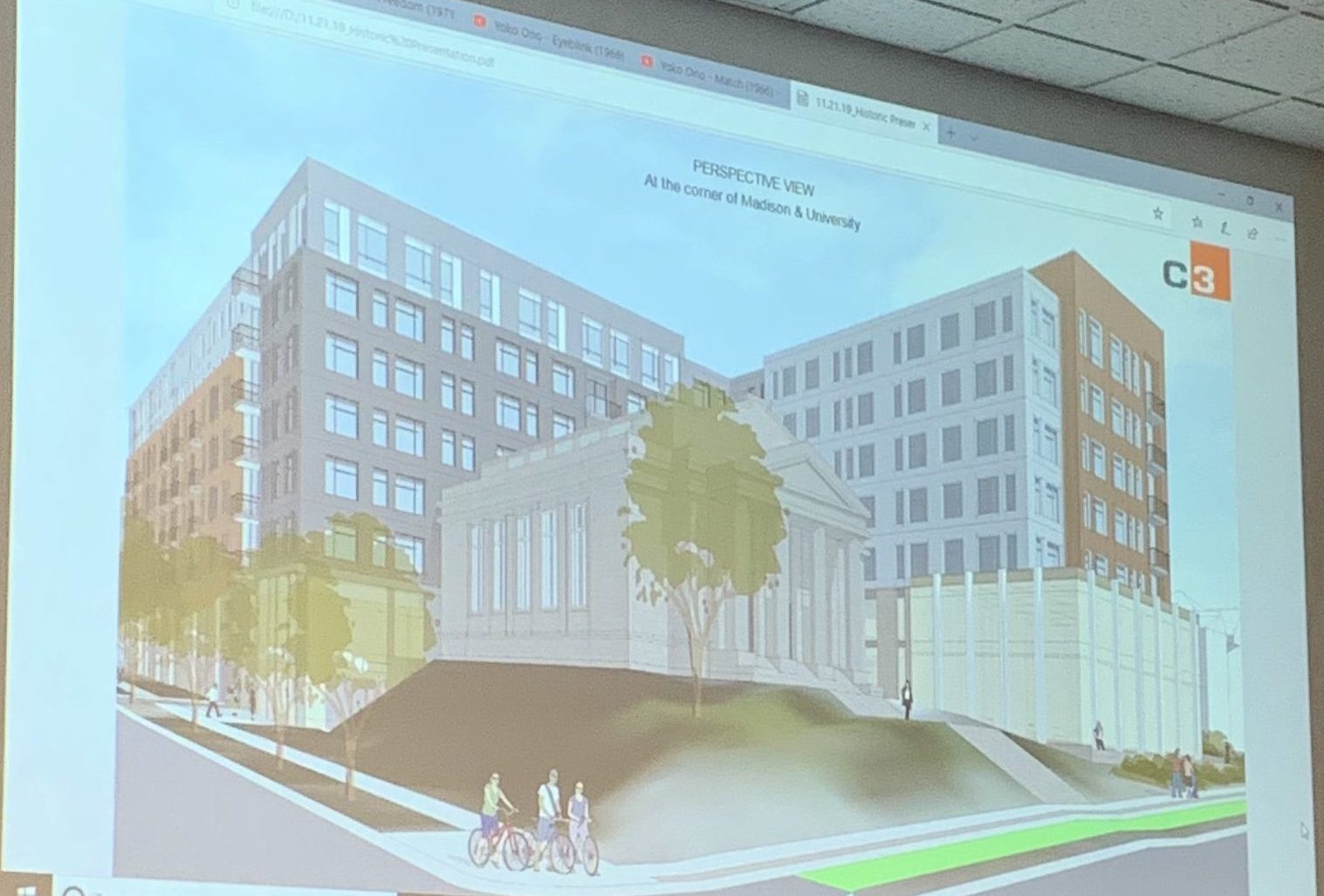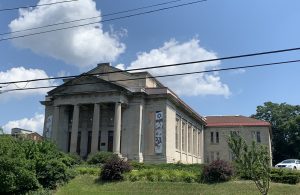Landmark Properties reveals initial Temple Concord plans
Landmark Properties unveils Temple Concord plans

Landmark Properties, the real estate firm that bought the Temple Concord building this past summer, proposed its first draft of plans last month for the property as a luxury student apartment complex.
In big cities across the country, religious buildings are increasingly being sold to developers and transformed into apartments and hotels, Vice Chairman of the Syracuse Landmark Preservation Board Rob Haley said. As congregations often struggle to make enough money to keep their buildings, developers are seizing the business opportunity to turn these buildings into attractive living spaces for the public.
Rabbi Daniel Fellman of the Temple Concord Syracuse and Cheri Lass, the executive director, did not respond to multiple phone and email requests for comment. Cantor Kari Siegel Eglash of the Temple Concord Syracuse said that leaders of the congregation no longer taking any requests for comments or interviews from student journalists.
Landmark Properties and CUBE 3, the architecture team that it hired for the project, presented their tentative plans for the historic temple to the Syracuse Landmark Preservation Board.
In the first draft of plans, CUBE 3 team members showed detailed drawings of what the temple would look like after the hypothetical construction was completed. The luxury student apartment complex would be at most eight stories tall, with 202 units, as well as ground floor parking and a glass fitness building. The structure would surround two sides of the temple.
“We want to save good synergy between the old and the new,” said John Harding, the senior associate principal of CUBE 3.
One presentation slide read that the potential apartment complex “creates a modest backdrop for the sanctuary,” and that the final property would “use a contrast of heavy vs. light, modern vs. historic to create a visual hierarchy.”
Members of the Board questioned the temple’s position at the center of this imposing modern building.
“Right now, that building is towering over what’s next door to it,” board member Julia Haftka-Marshall said.
Those on the development team of the said several times during the meeting that they will try to preserve the character of the historic temple as much as possible throughout the process of renovation.
“Where is that on your priority list?” Landmark Preservation Board member Lisa Tonzi asked.
After a beat, James Trasher, a senior associate at the engineering consulting firm Clough Harbour & Associates (CHA), chimed in.
“It’s at the top of our list,” Trasher said.
“I think we realize that this is a very unique space and that the project would be really successful if it was integrated appropriately with the temple,” Harding added.
The Temple Concord Syracuse has been in the city since the mid-1800s. Today, organized religious groups across the country are facing an overall shortage of money, and some congregations have made the decision to sell their place of worship in order to protect the congregation.
“Religious buildings are under pressure of being lost. So many of them are being converted because of their inherent quality and character, for commercial uses, like theaters,” Haley said.
An undecided factor that worried board members was whether the temple will be attached to the apartment complex in some way, or left free-standing. But either way, the plan that Landmark Properties presented would require a partial demolition; getting rid of all of the sections of the temple that were added in the 1920s and 1960s.
“The entire complex is on the national register, so partial demolition would trigger a local protected site review from the board, just so that you’re aware of that,” Auwaerter said to the developers.
Designating the property as a local protected site would instill further regulations and limitations for Landmark Properties and CUBE 3, regarding how they may change or renovate the temple.
Neither Landmark Properties nor CUBE 3 know what the function of the temple will be.
It will be used for something, though, Harding said, and CUBE 3 is currently discussing ideas of how the temple can be incorporated into the project.
“The ambiguity of the future of the actual structure is concerning to me. I feel like: it’s not an afterthought, but it’s not the core of the project. I’m concerned about that,” Tonzi said. “I don’t want it to go, and just sit and sit and sit, and not have an absolute connection to the project.”

The uncertainty about the way in which the temple will function also concerned other board members.
“The absolute worst outcome for this would be an unusable, mothball space. That just defeats the entire purpose of this discussion,” said Kate Auwaerter, the city’s preservation planner.
Multiple developers reassured the Board that they were already having ongoing conversations about the potential use of the temple.
“At this point, Landmark [Properties] is full steam ahead trying to figure out how do we get the most value out of it and the best use for everybody,” Harding told the Board.
Landmark Properties is one of many developers that see the potential financial value of converting religious buildings into living spaces. Religious properties that become apartments appeal to the public.
“It’s wonderful because you have the stained glass, you have the woodwork, you have everything,” Haley said.
And the charm of rooming in a historic religious temple sells.
Another building Syracuse followed this same pattern: the former Temple Adath Yeshurun on South Crouse Avenue, which is now The Hotel Skyler. The Congregation moved to the temple in 1921, which was later turned into a performing arts center in 1972. In 2009, a developer bought and converted it into the Hotel Skyler that it is today, according to the Historic Hotels website, which is the official organization of the National Trust for Historic Preservation.
The Hotel Skyler, with 58 rooms and an average occupancy rate of 75% year-round, has an average room rate of about $213 during its busier seasons (March through September) and $133 during its quieter seasons (October to February); according to a receptionist working at the front desk of Hotel Skyler, who requested anonymity. Based on these numbers, the revenue from the rooms at the Hotel Skyler brings in roughly $2.7 million a year.
Luxury student apartments in Syracuse — of which the Temple Concord building will likely soon be one — bring in more revenue.
The student apartment complex Park Point has a total of 66 apartments, all of which are full for this year, according to the front desk receptionist. Its two-bedroom, one-bathroom apartments start at $1,594 per month, per person. Its four-bedroom, two-bathroom apartments start at $1,244 per month per person. Based on this data, rent brings in about $3.2 million a year for Park Point.
Another upscale student apartment building, the 505 on Walnut, has a 99.72% occupancy rate for the 2019 to 2020 school year and 126 rooms in all. The average apartment rate is $2,835 per month. Based on these numbers, the rent revenue for The 505 on Walnut is roughly $4.8 million per year.
Landmark Properties’ conversion of the Temple Concord into a luxury student apartment complex could bring in around the same revenue as Park Point and the 505 on Walnut. The firm is to make its first formal proposal to the Syracuse Landmark Preservation Board this Thursday, which will lay out the potential plan for the Temple Concord building.
Andrew Costas, director of development at Landmark Properties, did not respond to multiple requests for comment by email and phone.
As Landmark Properties finished presenting its plans for the Temple Concord building, Haley stressed to the developers that the Board was not trying to tell them what to do, but rather to work with them on this project and provide guidance.
“Take this as response and not as what you have to do. Try to remember it’s your project,” Haley said to the developers.
After concluding their presentation, the individuals from Landmark Properties and Cube 3 departed, and the Landmark Preservation Board was left alone to further discuss the matter and close its meeting.
“Can I just say something?” Tonzi said amidst buzzing chatter from the Board. “I’m very skeptical about how important that temple is to them.”
“It’s not,” Haley, Auwaerter, and another board member, Tom Cantwell, replied in unison.
“I see this project as another example of things that have come before us, where a developer wants to…maximize the amount of space and the height to put up as much rentable space as possible,” Cantwell said. “I think it is, in part, our duty to try to keep that somewhat in check.”








